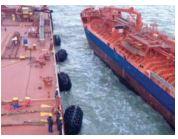202152 STS transfer ends with a touch of bows
A tanker was anchored with nine port shackles in the water, awaiting the arrival of the receiving vessel to carry out a STS transfer operation. The compatibility of the vessels for STS operations had been confirmed by the STS organiser and a pre-transfer information exchange between the two vessels had been done. Fenders were rigged at the starboard side to accommodate the receiving vessel. The receiving vessel berthed without incident and the STS transfer was completed over approximately 12 hours. Unmooring then commenced under the supervision of the STS supervisor, who was on board the receiving vessel.
The STS supervisor first requested the discharging vessel to heave up five shackles and remain anchored with four shackles in the water. Unmooring then commenced. Within 10 minutes the receiving vessel started moving away from discharging vessel using her bow thruster and main engine. When the distance between the vessels was about 15-20 metres, the STS supervisor thought that the bow thruster of the receiving vessel was sucking a fender rope, so he stopped the thruster. Within seconds, the prevailing current caused the bow of the receiving vessel to drift towards the discharging vessel. The two vessels came into slight contact.
The unmooring manoeuvre was suspended and the discharging vessel was instructed by the STS supervisor to heave up her anchor fully. Once the anchor was retrieved, the unmooring operation was resumed underway and the vessels successfully separated. Except for paint scratches, no damage or deformation to vessel’s side shell was observed.

Lessons learned
- Weather conditions were optimum, and as such the unmooring operation could have been carried out safely with both vessels underway – which is how it was accomplished after the incident. A well-coordinated STS unmooring while underway gives more ‘leverage’ over external forces such as current.
- Fenders may be secured on either vessel, but contacting an unprotected portion of the hull is less likely if the fenders are rigged on the manoeuvring ship.
Editor’s note: STS best practices from the pages of the Skuld website; (https://www.skuld.com/topics/cargo/liquid-bulk/ship-to-ship-transfer-safety/)
The most common incident during STS operations is contact/collision between the two ships while manoeuvring alongside each other, or upon departing. There are many reasons for this, including:
- Incorrect approach angle between the manoeuvring vessel and constant heading (mother) ship;
- The manoeuvring ship approaching at excessive speed;
- Failure of one or both ships to appreciate meteorological and/or tidal conditions;
- If underway; the mother vessel not maintaining a constant heading and speed;
- If at anchor; the mother vessel failing to control excessive swinging and/or the manoeuvring ship failing to appreciate the swing;
- Miscommunication between the vessels during manoeuvring.
- Bridge wing to bridge wing touch for ships of similar length.
